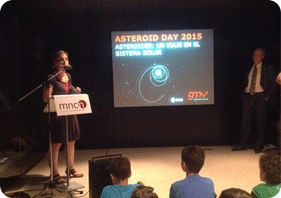GMV joins in the worldwide initiative ”Asteroid Day”

On 30 June the Spanish Natural Science Museum (Museo Nacional de Ciencias Naturales: MNCN-CSIC) hosted Asteroid Day 2015, a worldwide initiative that aims to raise awareness about the need to protect our planet and its life forms from any future asteroid impact. The date of 30 June was chosen to mark the anniversary of the largest asteroid impact in recent history, the 1908 Siberian Tunguska Asteroid Impact, which burnt a woodland area of 2150 km2.
The event was held in MNCN’s meteorite room, displaying one of Europe’s most important meteorite holdings, with pieces of incalculable scientific interest giving crucial insights into the origin of the solar system. The museum researcher Javier García Guinea explained how the study of meteorites has contributed to scientific development by inputting information on the makeup of the earth’s core. GMV, represented by its Executive Director of Space Systems, Mariella Graziano, ran through past and future asteroid missions, explaining their contribution to our knowledge of planetary science and outlining their technical difficulties and objectives.
Mariella Graziano particularly underlined the importance of ESA’s AIM mission, soon to be launched towards the Dydimos asteroid. This is a binary asteroid; the primary asteroid measures 800 meters while the satellite, called Dydimoon, measures 170m; the two lie 1.2 kms apart from each other. ESA plans to launch a low-cost mission called Asteroid Impact Mission (AIM) to this binary asteroid to determine in a detailed way the energy transfer resulting from the impact of a probe against the secondary asteroid (to be gauged by measuring the asteroid’s speed after the impact and photographing the impact crater) and also to monitor the dust environment before and after the impact as a function of time. The aim is to explore and demonstrate technologies for future asteroid missions, studying what we can do to head off any asteroid impact on Earth. This is where GMV comes in; it is responsible for mission analysis, the guidance, navigation and control (GNC) subsystem and an important part of operations design, in one of the two ESA studies currently underway.
AIM is an active part of the Asteroid Impact and Deflection Assessment (AIDA) project of ESA, DLR (Germany), the Observatoire de la Côte d´Azur (France), NASA, and Johns Hopkins University Applied Physics Laboratory (JHU/APL), designed to assess the potential of the kinetic impactor concept for deflecting nearby asteroids. The second component of this mission is the DART satellite (Double Asteroid Redirection Test), which is American. AIM’s 200-million-euro budget places it among low-cost missions. The fate of the AIM mission is to be decided in the upcoming Ministerial Conference scheduled for late 2016. If approved, AIM would be launched in 2020 aboard a Soyuz-ST rocket from French Guiana towards the Didymos asteroid. Arriving 18 months later, it would then begin its analysis of Didymoon while the binary asteroid system is passing about 11 million kilometers from Earth (30 times the Earth-Moon distance).
Once at the asteroid, AIM will study the secondary body Didymoon by means of two radars, the infrared camera TIRI (Thermal Imager) and the camera VIS (Visual Imaging System), which will build up a 1-meter resolution map. At the same time AIM will release two mini satellites for scientific research purposes and also the Lander MASCOT-2 of Germany’s Aerospace Center, DLR. One of the new features of this mission is use of the Optel-D laser communications system to send recorded information back to Earth, specifically to ESA’s Optical Ground Station (OGS) in Tenerife.
In October 2022 AIM will observe the 6 Km/s impact of the DART satellite against Didymoon. DART will be carrying a camera to record 20-centimeter-resolution images of the asteroid moments before the impact. AIM and DART will work jointly to determine the energy transfer resulting from DART’s impact against the secondary asteroid and monitor the dust environment before and after the impact as a function of time.